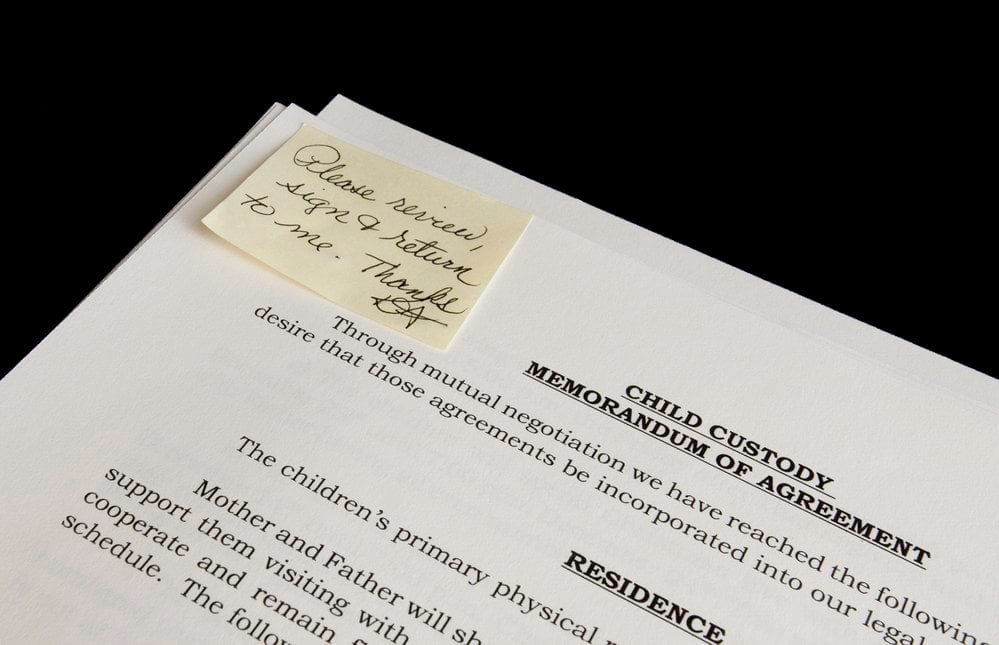Divorce comes with several challenging issues. Besides its emotional effects, couples face several legal and financial issues during this time, especially when they have children. The question of who gets custody in a divorce immediately arises when one partner asks the other for divorce.
Several decades back, the usual practice was to give the children to the mother, who was considered the person they invariably needed the most (attachment figure). Fathers got a standard visitation schedule, most often every other weekend, with no further say.
Psychology Today delves into the issues of attachment figures, saying that research shows children have more than one. Besides their parents, other important people in children’s lives include their grandparents, nannies, and any other people they build a bond with. Most importantly, courts recognize the benefits to children of giving both parents equal parental rights.

Factors Affecting Child Custody
Parents must consider several factors when negotiating the complexities of child custody. It’s crucial not to upset the children by fighting in front of them or badmouthing each other to the children. Another essential element is to consider the long-term needs of the children in the settlement, which includes their college costs.
If parents cannot decide on physical custody, legal custody, child support, etc., the family court decides for them.
These are the most critical factors affecting child custody:
Child’s Best Interests – The primary consideration in physical custody (where the child spends most of the time) is the child’s best interests. Courts aim to make decisions that ensure a stable and nurturing environment for the child’s physical, emotional, and psychological well-being.
Parent-Child Relationship – Courts assess the relationship between each parent and the child. Factors such as the quality of the bond, emotional and physical support, and the ability to meet the child’s needs are all considered.
Parental Fitness – The court evaluates the fitness of each parent as a caregiver. The assessment includes the parent’s physical and mental health, any history of substance abuse, criminal record, and any evidence of child abuse or neglect.
Stability and Continuity – Courts often favor maintaining stability and continuity in the child’s life. They examine the current living situation, school, community, and social ties.
Co-Parenting Ability – The ability of each parent to cooperate and effectively co-parent is a significant factor. Courts encourage parents to work together in the child’s best interests. A parent’s willingness to facilitate a healthy relationship between the child and the other parent can prove significant.
Parenting Plans – Courts may consider how the parents propose to provide for the child’s physical, emotional, and educational needs. The parenting should also address visitation schedules, transportation, and communication.
Child’s Preference – Depending on the child’s age and maturity, courts may consider their preference. However, it is one of many factors considered and not determinative.
Geographic Proximity – Proximity between the parents’ residences can be a relevant factor determining the impact on the child’s ability to maintain relationships with both parents.
Domestic Violence or Abuse – Evidence of domestic violence, child abuse, or neglect can significantly impact custody decisions. Courts prioritize the safety of the child and may limit or restrict the abusive parent’s contact.
Parental Work Schedule – Both parents’ work schedules and commitments can affect custody arrangements because the custodial parent must have time to provide appropriate care.
Support Systems – A support system, such as extended family or close friends, can be a factor.
The weight of these factors can vary from case to case, and judges have some discretion in making custody decisions. Additionally, laws and guidelines regarding child custody may differ by jurisdiction. Parents should consult with a family law attorney to ensure they understand the factors affecting child custody in their state.
Types of Child Custody Arrangements
The circumstances of the parents can determine the type of custody arrangement. These are some of the most typical arrangements:
Sole Physical Custody
In this arrangement, one parent has primary physical custody of the children. They reside primarily with that parent. The other parent has visitation rights or parenting time but does not have the child living with them most of the time.
Both parents must follow the visitation rights schedule arranged in the custodial agreement. The non-custodial parent cannot take the child without the custodial parent’s consent, and the custodial parent cannot refuse a scheduled visit under normal circumstances. Legally, some circumstances allow the custodial parent to deny a visit to the non-custodial parent. These include fearing imminent harm to the child from abuse or neglect or the child refusing to go.
Any violation of visitation rights from either parent can have serious consequences.
Joint Physical Custody
Nowadays, courts in some states award joint physical custody by default, guaranteeing the children maintain contact with both parents. It means that a parent disagreeing with this must prove why.
Joint physical custody is when the parents get the child equally. The child splits their living time with both parents. The specific schedule can vary, but it typically aims for the child to spend roughly equal time with each parent, allowing both parents to enjoy essential aspects of their children’s lives.
Legal Custody
Legal custody is the authority to decide about issues affecting your child’s upbringing, such as education, medical care, and religion. Parents mostly get joint legal custody, where they share the responsibility of making major decisions about the child and make collaborative decisions.
However, sometimes courts award sole legal custody to one parent even though it is rare that one parent makes all the decisions about the child’s upbringing without consulting the other parent.
Non-Parental Custody or Guardianship
Sometimes, a relative or close family friend may seek custody of the children if they feel it’s better for them. It’s known as non-parental custody or guardianship. They file a petition with the court, and if the parents consent, they present it to the court. Courts decide after completing a background check.
Split Custody
A split custody arrangement is sometimes possible in cases with multiple children. Each parent gets primary physical custody of at least one of the children. These arrangements are less common because they split siblings and can prove emotionally challenging for them.
Bird’s Nest Custody
Bird’s nest custody is a less common arrangement where the child remains in one primary residence, and the parents take turns living in that residence with the child. Both parents usually have a separate living arrangement for when they aren’t with the child.
Parallel Parenting
In high-conflict situations or when parents have difficulty cooperating, parallel parenting involves strict boundaries and minimal direct communication between parents while adhering to a detailed parenting plan.
Supervised Visitation
In cases where safety concerns exist, the court may order supervised visitation, where a third party or professional supervisor oversees visits between the non-custodial parent and the child to ensure the child’s safety.
The specific conditions of custody arrangements can be highly customized and depend on the parents’ unique circumstances and the child’s best interests.
Best Interests of the Child
Determining the child’s best interests is fundamental in child custody cases. While the specifics can vary by jurisdiction, some common factors that courts typically consider when assessing the best interests of the child include:
Physical and Emotional Health of Each Parent – Each parent’s physical and mental well-being is crucial for courts, ensuring children have the care needed in a stable and healthy environment.
Emotional Ties and Relationships – The strength and quality of the child’s emotional binding with each parent and any siblings are significant to ensuring continuity in existing relationships.
Ability to Provide Stability – Courts assess the stability of each parent’s home environment. These include a stable living situation, neighborhood, and the child’s familiarity with the surroundings.
Educational Opportunities – The court may consider the educational opportunities, the proximity of the school, and each parent’s commitment to the child’s education.
Cultural and Religious Considerations – If religion and culture are significant aspects of the child’s life, the court may consider each parent’s ability to support and facilitate the child’s religious and cultural upbringing.
Parental History of Caregiving and Involvement – The court may evaluate each parent’s history of caregiving and involvement in the child’s life, like day-to-day care, input in school and extracurricular activities, and overall parenting responsibilities.
Willingness to Support Relationship with the Other Parent – Courts generally favor parents willing to support and encourage positive relationships between the children and the other parent. They also consider the parental ability to cooperate and communicate in their co-parenting duties.
History of Abuse or Domestic Violence – The court takes allegations or evidence of child abuse, domestic violence, or neglect seriously. The child’s safety is a top priority, and a history of such incidents may impact custody decisions.
Child’s Wishes – In some jurisdictions, the court may consider the child’s preferences, especially as they get older and more mature. However, this factor is only one of many that will give weight to the court’s decision.
It’s important to note that the weight given to each factor can vary based on the case’s specific circumstances and the jurisdiction’s laws. Ultimately, the goal is a custody arrangement that serves the child’s best interests and promotes their well-being.

Child Custody Mediation Process
There are two ways for parents to reach a custody agreement. They can do so informally between themselves or through mediation. If they can’t reach an agreement, the court decides based on the children’s best interests.
Both parents negotiating custody of their children should seek legal advice before making any agreements, advises Expertise.com. Once they are sure, they draft and sign the settlement or custody agreement. The court approves the finalized agreement during the divorce proceedings, and it becomes a binding contract that both parents must adhere to.
These are the usual steps in the child custody mediation process:
Informal Negotiation
Private negotiations, with or without hiring attorneys, are one way for parents to reach a custody agreement. Parents can successfully negotiate amongst themselves if they both put the best interests of their children first. Once they have decided, they can hire attorneys to finalize the agreement. In tense relationships, parties often negotiate custody through their representative attorneys.
Mediation
Mediation offers a collaborative environment for cases where informal negotiations don’t work. Moreover, mediation is less hostile than a court setting.
During the structured mediation process, a neutral third party helps the divorcing couple settle disputes over the children’s custody issues. During the initial meeting, the parents and mediator agreed on an agenda. In the follow-up meetings, they work toward an agreement. Once both parents approve the terms, the mediator prepares the custody agreement that the court finalizes.
Family Court
In cases where emotions or other circumstances make it challenging to settle a custody dispute, the court must decide. Courts always investigate the child’s best interests before granting custody and visitation rights based on the jurisdiction.
Factors courts use to make a decision include:
- Parent’s Living Circumstances – For stability reasons, the parent awarded the family residence often gets custody. Other factors the court considers are the proximity to the children’s school and social activities.
- Parent-Children Relationship – Judges consider each parent’s willingness to provide for the children after the separation. However, they may also consider what they have offered before.
- Parent’s Willingness to Support Their Children’s Relationship with the Other Parent – Courts look for signs that the parents are willing to cooperate and not interfere with the children’s relationship with each parent.
- Children’s Preferences – If the children are older, some courts may consider their preferences about custody and visitation. In some jurisdictions, this is a requirement, but not in all.
- Age of Children – Even though this is less pertinent today, some judges may still grant custody to the mother in cases with younger children (especially nursing infants).
- Stability – Judges prefer to give custody and visitation arrangements that ensure the children can smoothly transition during a difficult emotional period.
- Parental Sexual Orientation – States that recognize same-sex marriages don’t take parental sexual orientation into account when granting custody and visitation rights. However, it is a consideration in some states.
- Abuse or Neglect – If there is any sign of abuse or neglect, the court will limit a parent’s contact with the children.
Child custody in divorce can prove challenging unless the parents work together on a parenting plan that addresses their children’s needs. If parents cannot agree, the court will decide based on the child’s best interests. Legal professionals, such as family law attorneys and mediators, can assist parents in navigating the child custody process during divorce.



